Meet Our New KEYS Americorps Member, Kelsea!
Hi everyone, my name is Kelsea and I am very excited to be a part of the Women for a Healthy Environment team! I will be serving the WHE through the KEYS Service Corps for the next nine months. KEYS Service Corps, standing for Knowledge to Empower Youth to Success, assists with mentoring and tutoring students, provides opportunities for afterschool programs and activities, and leads youth to make progressive impacts in their community. Serving through WHE allows me to assist educating and spreading awareness to the Pittsburgh community about environmental issues and risks that affect schools and homes. Specifically, WHE’s Eco-Schools Program, which will be my main focus, encourages and inspires children to implement sustainable practices in their own lives, as well as in their community and schools. I am very excited to share what I am passionate about, and I am looking forward to gaining experience and knowledge about environmental issues that affect the Pittsburgh area.
In May, I graduated from Washington & Jefferson College with a bachelor’s degree in Public Policy, with a focus in Environmental Policy. I would love to continue my education after serving with AmeriCorps; possibly narrowing down a specific environmental track, like food sustainability or urban planning. All my life, I have grown up in New Jersey and I am very excited and grateful to have an opportunity to live in a new city. Since I was young, I have always enjoyed being outdoors, especially spending time outside with my family and friends. I enjoy traveling, doing outdoor activities, and learning new ways to implement sustainable practices into other people’s and my own lifestyle.
Even though COVID-19 has made it hard to go back to normal schooling, I am very excited to be serving and educating Pittsburgh’s students, whether that be virtual or in person learning. Hopefully in a few short months, we can all safely return back to normal and I can meet everyone in person! I look forward to working with students, as well as collaborating with the like-minded individuals who enjoy making the Pittsburgh community a better place for everyone.
We are so excited to welcome Kelsea to Pittsburgh and to the Women for a Healthy Environment Team! If you or your school are interested in learning more about our environmental health curriculum, STEAM activity kits, or other educational offerings, you can email Kelsea at kelsea@womenforahealthyenvironment.org.
Taking Action on Childhood Cancer Prevention

For the last 50 years, the incidence of childhood cancer has been steadily rising in the United States. The amount of concern among scientists and medical professionals that environmental chemicals are contributing to the rising cancer rates has also been growing.
An important new report released yesterday by the Childhood Cancer Prevention Initiative finds “cross sector” opportunities for doctors, scientists, businesses, and policymakers to reduce hazardous chemicals entering the environment and preventing cancer:
While adults and young people can breathe in, swallow, and absorb hazardous chemicals through their skin, children face added risks through maternal or paternal transfer of toxics. Reducing production and use of chemicals that can cause cancer is an opportunity for childhood cancer prevention.
Even though survival rates of children diagnosed with cancer have improved thanks to exciting breakthroughs in research and treatments, pediatrician and public health expert Philip Landrigan, M.D., knows very well that “childhood cancer is a dreaded disease”:
In 2019, more than 16,000 children in the United States were diagnosed with cancer. These children have leukemia, brain cancer, kidney cancer, bone cancer and more. Fifteen percent of them will not survive beyond five years. Cancer is now the largest cause of death from disease in American children.
In the foreword to Childhood Cancer: Cross-Sector Strategies for Prevention, Dr. Landrigan observes that despite falling death rates, the incidence of childhood cancer — the number of new cases per 100,000 children — has been steadily increasing in the United States:
Since the mid-1970s, cancer incidence rates in American children have increased sharply. From 1975 to 2017, leukemia incidence rates increased by roughly 34%, and incidence rates of brain and other central nervous system cancers increased 40%.
These increases are too rapid to be due to genetic change. They cannot be explained by increased access to medical care or by improvements in diagnosis. Recognition is growing that hazardous exposures in the environment are powerful causes of cancer in children.
Yesterday on The PediaBlog, we examined a list of chemical contaminants that may contribute to cancer in children and adults. Dr. Landrigan adds a few more:
Maternal exposure to ionizing radiation such as X-rays during pregnancy, and early childhood exposures to CT-scans, have been found to increase risk of childhood leukemia and brain tumors. Prenatal exposure to diethylstilbestrol (DES) causes adenocarcinoma of the vagina in female fetuses. In more recent years, robust evidence has emerged for other links, including traffic-related air pollution, paints, and solvents such as benzene, which elevate risks of leukemia, lymphoma and brain tumors. Prenatal exposures to pesticides are associated with increased incidence of leukemia. Children living in communities surrounded by manufacturing facilities, refineries or intensive agriculture—where residents are often low-income or people of color—may have particularly high exposures.
There are three sources of chemicals that generate the highest concern regarding the development of pediatric cancer. The hopeful fact is that exposure to these risk factors can be significantly reduced:
- Air pollution, especially traffic-related pollution but also emissions from fixed, industrial sources. Some carcinogenic air pollutants, including benzene, formaldehyde, and 1,3-butadiene, are strongly linked with childhood cancer, and are emitted from vehicles and factories. The risk is heightened in children who begin breathing polluted air at a young age.
Potential avenues of action for reducing the risk of cancer from ambient air pollution include transitioning away from diesel- and gasoline-run vehicles, enforcing no-idling laws, and siting new schools and homes away from busy roadways and factories. Monitoring emissions and holding industrial polluters accountable by enforcing laws and regulations designed to protect public health would go a long way in reducing air pollution and cancer risk.
- Pesticides used on crops and at home. Occupational and residential exposure to insecticides, herbicides, and fungicides in either parent before conception, during pregnancy in the mother, and early in life has been linked to the development of leukemia, lymphoma, and brain cancer in children.
Pesticides are toxic by design and therefore more dangerous in children. They shouldn’t be used where children live, go to school and play (especially on lawns), and where pregnant mothers can be exposed. Parents should explore alternative methods of insect control in and around the house that don’t involve toxic chemicals. In Pennsylvania, schools are required to implement Integrated Pest Management, which alerts parents, teachers, and staff before chemical pesticides are applied. Additional regulations like this one are likely to reduce exposure to pesticides in children.
- Indoor chemical exposures, especially paints and solvents. Current research links parental exposures and maternal exposures during pregnancy to increased pediatric cancer risk. Benzene is an example of a commonly used solvent associated with cancer in adults and children. A component of oil and natural gas, benzene is used as a solvent in fracking operations and is a chemical byproduct when fossil fuels are burned.
Other indoor carcinogens include outdoor air pollution infiltrating indoor air, radon gas (the second-leading cause of lung cancer after tobacco smoke), toxic off-gases like formaldehyde coming from building materials, furniture, and flooring, and chemicals contained in cleaning products, disinfectants, and cosmetics.
While most other advanced countries apply the precautionary principle and test their products for safety and toxicity before they enter the marketplace, the U.S. takes the reactionary approach which doesn’t protect anyone, especially children.

More than 85,000 chemicals are in use by industry and consumers in the United States. Very few of them have actually been tested for safety or toxicity in adults, and practically none of them have been studied in children. Yet there is growing concern that more than a few of these chemicals might be driving the increase in pediatric cancers. “We are flying blind with no instruments,” worries Dr. Landrigan. Confronting rising cancer rates in children by requiring all new chemicals and all widely used existing chemicals to be tested for safety and toxicity in children is urgently needed:
We need to launch a National Cancer Prevention Plan—a second front on the War on Cancer—a powerful program of intervention against the root causes of childhood cancer that will complement and sustain the great advances we have made in cancer treatment.
There’s a case to be made that researchers, industries, businesses, consumers, and policymakers all have an opportunity as well as a responsibility to help to solve this childhood cancer crisis in America. Dr. Landrigan knows that the health and well-being of our children is at stake:
To be successful, the National Cancer Prevention Plan needs the support of people in every sector of American society, in every region of our great country and of all political beliefs and persuasions. This plan is about our children, our values as a country, and ultimately about our future.
Parents are often unaware of children’s exposure to toxic chemicals where they live, go to school, and play. Contained in this report is new knowledge that will help parents make good choices to protect their children, including reducing exposures to toxic chemicals prior to getting pregnant or during pregnancy, not just during the first years of life.
Unfortunately, many sources of toxic chemicals are beyond an individual’s control. People living in southwestern Pennsylvania still breathe chemical pollution from older coal-fired power plants and steel-making facilities, as well as more recent threats to health coming from rapidly expanding fracking and petrochemical operations throughout the region.
Businesses and governments have a responsibility — and an enormous opportunity — to accelerate the reduction in the manufacture and use of toxic chemicals. Doing so gives families the best chance at a cancer-free future.
With knowledge comes responsibility. It is time to take preventative measures NOW to reduce the number of children diagnosed with cancer.
September is Childhood Cancer Awareness Month. Read the full report on childhood cancer prevention and the reasons why action is needed now, here. Watch yesterday’s press conference announcing the report’s release here.
Dr. Ketyer participates in the SWPA Cancer and Environment Network which brings together cancer-focused organizations, academics, community groups, environmental leaders, and others to follow the relevant science, and collaborate to reduce environmental carcinogens as a critical — and often overlooked — pathway for cancer prevention. Dr. Ketyer is also a member of Women for a Healthy Environment’s Science Advisory Committee. This blog is reproduced with permission.
Introducing our Healthy Schools Advisory Board members!
Every year, we have the absolute honor and pleasure of inviting stakeholders who represent the school communities we serve to join our Healthy Schools Advisory Board. Our board is a collection of individuals who bring unique knowledge and skills to more effectively guide the organization. Our board members help us set priorities for our programming, evaluate our impact, advocate for our organization, and provide feedback and technical expertise from the community about school needs, among other responsibilities. Meet our board members below!
Judy Brand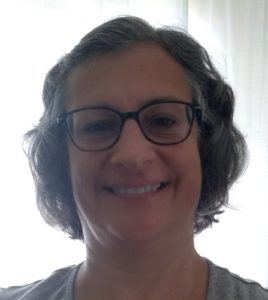
I am a certified school nurse and have been with the Environmental Charter School for 10 years. Our school has a huge focus on green cleaning and environmental concerns, so getting involved with Women for a Healthy Environment went right along with our school’s guiding principles. Our school has worked with Kara and Dr. Gentile on air quality issues in the past and are excited to continue!
Cassandra Brown 
I am a nurse practitioner for Pittsburgh Public Schools. I graduated from Carlow University with a Master’s degree in Nursing Administration, education and leadership and obtained a second Master’s degree, also from Carlow, several years later as a family nurse practitioner. Cassandra has been an advocate with Family Support for almost 26 years. She serves on the advisory committees of the Institute of Medical and Business Careers, and the Board of Directors for the Rosedale Food Pantry.
Joe Domagala
I currently serve as an Assistant Principal at Eden Hall Upper Elementary School in the Pine-Richland School District. In addition, I also serve as an Adjunct Instructor of Information Systems Management at Duquesne University and participate as a member of PA Healthy Environment and Reopening Schools Workgroup. During my time at Eden Hall Upper Elementary School, we have increased our focus on green school initiatives, participated yearly in the PA-Healthy Schools Report Card award, and have been designated as a 2019 U.S. Department of Education Green Ribbon School. Working with our students and teachers to identify and implement initiatives that focus on a healthy and sustainable environment serve to benefit our children, their families, and our greater community.
Sarah Fuller
I have been teaching fourth and fifth grades at Pittsburgh Urban Christian School (PUCS) in Wilkinsburg, PA since 2007. Last year, as part of my integrated unit about the circulatory and respiratory systems, my students and I began working with Women for a Healthy Environment on a multi-faceted air quality project. I found myself both deeply interested and engaged in issues of poor air quality in our region, and I want to continue learning and working towards solutions!
Jessica Griggle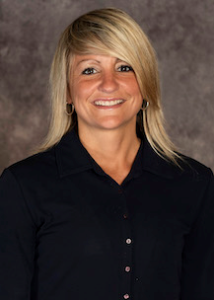
I am the Food Service Director for Plum Borough School District. I have been with the District for 5 years. I became involved with Women for a Healthy Environment when I started researching composting and green products for use in our school cafeterias. I am dedicated to ensuring all children have an opportunity to receive and enjoy healthy and nutritious meals. I am currently working not only to provide these meals but to do so while protecting our environment by using sustainable products and decreasing food waste.
Ameeta Schmitt
 I am an Assistant Principal at Pittsburgh Brashear High School. Formerly, I taught grades 9-12 for seven years as a Foreign Language instructor. I recently completed my Doctorate in Education where my work focused on language, literacy, and culture. Throughout the program, I was also involved in Social Justice Advocacy work. Being an employee in a highly diverse building has stretched my thinking about what it meant to have a healthy school. The more I learned, the stronger my drive to strive for healthy school grew. For me, a primary focus is on the prevalence of food desserts in parts of the city and lack of public transportation to access food sources.
I am an Assistant Principal at Pittsburgh Brashear High School. Formerly, I taught grades 9-12 for seven years as a Foreign Language instructor. I recently completed my Doctorate in Education where my work focused on language, literacy, and culture. Throughout the program, I was also involved in Social Justice Advocacy work. Being an employee in a highly diverse building has stretched my thinking about what it meant to have a healthy school. The more I learned, the stronger my drive to strive for healthy school grew. For me, a primary focus is on the prevalence of food desserts in parts of the city and lack of public transportation to access food sources.
Lorna Rosenberg
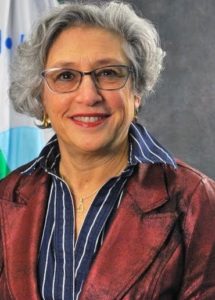
I am Lorna Rosenberg, LEED Green Associate and recent retiree from the US EPA Region 3 office in Philadelphia after 36 years of service. In the past 20 years my focus has been green buildings, green and healthy school, sustainable communities and disaster relief. My focus on schools led me to be a founding member of the Pennsylvania Green and Healthy Schools Partnership – promoting Green Ribbon Schools in Pennsylvania and have been a trainer for EPA’s Tools for Schools Indoor Air Quality Program at many conferences and events around the Commonwealth. I headed the “green committee” in my school district – Cheltenham Township, Montgomery County 2016-2017. My concern in my “working” retirement, as in my time with EPA, is to see that all children and staff in schools with healthy environments in which to teach and learn. I live in Montgomery County,
Tiffany Ward
 I am currently entering my 10th year of education as a Math Academic Coach at Pittsburgh Allegheny 6-8. I previously have taught in primary self-contained classrooms and upper elementary departmentalized math. In April 2020 I began an initiative called The Pittsburgh Village Project, which focuses on uniting our community to create educational resources that ensure equitable learning during the Covid-19 school closures and beyond. I am passionate about using and creating real-world, project-based, engaging curricula as a means to racial and economic justice. I am excited about partnering with Healthy Schools to engage in work that gives students a voice in creating and sustaining healthy communities through learning!
I am currently entering my 10th year of education as a Math Academic Coach at Pittsburgh Allegheny 6-8. I previously have taught in primary self-contained classrooms and upper elementary departmentalized math. In April 2020 I began an initiative called The Pittsburgh Village Project, which focuses on uniting our community to create educational resources that ensure equitable learning during the Covid-19 school closures and beyond. I am passionate about using and creating real-world, project-based, engaging curricula as a means to racial and economic justice. I am excited about partnering with Healthy Schools to engage in work that gives students a voice in creating and sustaining healthy communities through learning!
Britnee Weatherspoon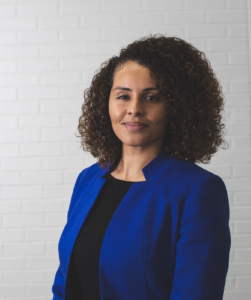
I am currently a District Administrator at Clairton City School District where I oversee attendance, coordination of social services and school health initiatives, and serve as the homeless and foster care liaison. I am a National Cadre Trainer for the Dove Self-Esteem Project, and a recent graduate from the University of Pittsburgh completing my Doctor of Education degree with a concentration in Health and Physical Activity. My passion and experience align with incorporating the Whole School, Whole Community, Whole Child (WSCC) model to improve school health policies and practices. I am passionate about creating healthier school and community environments for underserved populations, ensuring that young people are afforded the opportunity to reach their full potential.
Guest Blog: Choosing Safer Athletic Playing Surfaces
Children need to spend time outdoors playing, exercising, and getting fresh air, especially during a pandemic when many are isolating at home. However, there is growing concern about the outdoor surfaces on which they play. Materials used in artificial turf can contain toxic chemicals and trap heat, leading to hazardous playing conditions. Grass playing fields, especially those that are maintained with organic practices, are a safer choice for children’s recreational spaces.
Many schools and communities face choices about whether to invest in natural grass fields or convert to artificial turf. Decision-making about play surfaces at the community level is often difficult, hindered by a lack of resources and by competing priorities. There can be confusion about the impacts of these choices on children’s health, costs, and playability.
The Massachusetts Toxics Use Reduction Institute (TURI) has compiled information on this topic to create educational resources to help communities protect children’s health and their environment. TURI’s work is based on the principles of toxics use reduction, which focuses on identifying opportunities to protect public health and the environment by reducing or eliminating toxic chemicals. Below is a summary of TURI’s findings on safer athletic fields. To see TURI’s full list of resources on safer play surfaces, visit www.turi.org/artificialturf.
Chemical Hazards
Artificial turf has several components, including synthetic grass carpet and infill that provides cushioning and keeps grass carpet blades standing upright. These materials can contain chemicals of concern.
Particular concerns have been raised about the use of recycled tire materials used as infill. Recycled tires contain a large number of chemicals, many of which are known to be hazardous to human health and the environment. These include polyaromatic hydrocarbons (PAHs); volatile organic compounds (VOCs); metals, such as lead and zinc; and other chemicals. Health effects of some of these chemicals can include cancer, hormone disruption, respiratory problems, and skin irritation. Alternative infills can also contain chemicals of concern. To learn more about chemicals in infill, see TURI’s report, Athletic Playing Fields: Choosing Safer Options for Health and the Environment. There are also concerns about per- and polyfluoroalkyl substances (PFAS) in artificial grass blades.

Children are uniquely vulnerable to the effects of toxic chemicals because their organ systems are developing rapidly and their detoxification mechanisms are immature. Children also breathe more air per unit of body weight than adults, and are likely to have more hand-to-mouth exposure to environmental contaminants than adults. For these reasons, it is particularly important to make careful choices about children’s exposures.
Environmental Concerns
There are several environmental concerns associated with artificial turf, including loss of wildlife habitat, contaminated runoff, and migration of synthetic materials. Contaminants that are harmful to aquatic life, such as zinc, have been found in stormwater runoff from artificial turf. Both infill particles and broken synthetic grass fibers can migrate away from playing fields, contributing to microplastic pollution. There are also problems with disposal and reuse of used artificial turf. Used synthetic turf is projected to produce between 1 million and 4 million tons of waste over the next decade.
Heat Hazards
Artificial turf can become much hotter than natural grass on a warm, sunny day. Experts note that high temperatures can lead to potentially life-threatening heat-related illnesses for athletes and other users. A number of studies have measured high temperatures on artificial turf, some as high as 160oF. Heat guidance is often based on air temperature and other factors, not including the temperature of the play surface, so the risk to athletes may be underestimated in many cases. Some communities, such as Burlington MA, choose to measure artificial turf surface temperatures to help determine conditions under which athletes may use artificial turf fields and the conditions under which their activities must be moved to grass fields. Learn more about this topic in TURI’s overview fact sheet, “Athletic Playing Fields and Artificial Turf: Considerations for Municipalities and Institutions.”
Natural Grass as a Safer Alternative
Natural grass can be a safer option for recreational spaces by eliminating many of the concerns noted above. Use of organic maintenance practices on playing fields also eliminates the need for toxic insecticides, herbicides, and fungicides.
Several communities use organic grass management on public properties such as schools and sports fields. In the Pittsburgh area, the Borough of Heidelberg began using organic maintenance for grass playing fields at Heidelberg Park in 2019, and has seen significant improvements in the quality of the fields.  The Bethlehem Center School District is currently making improvements to its soccer field using organic practices. The Dan Marino field is transitioning their grass maintenance to organic land care methods. The Phipps Conservatory provides accreditation in sustainable land care. In Massachusetts, the Springfield Parks and Recreation Department, the Town of Marblehead, and the Field Fund in Martha’s Vineyard use organic practices to maintain numerous athletic fields in their communities. Field users and those in charge of maintenance are very satisfied with the quality and playability of these grass areas. Elements of these programs include frequent aeration and careful application of organic fertilizers based on site-specific needs.
The Bethlehem Center School District is currently making improvements to its soccer field using organic practices. The Dan Marino field is transitioning their grass maintenance to organic land care methods. The Phipps Conservatory provides accreditation in sustainable land care. In Massachusetts, the Springfield Parks and Recreation Department, the Town of Marblehead, and the Field Fund in Martha’s Vineyard use organic practices to maintain numerous athletic fields in their communities. Field users and those in charge of maintenance are very satisfied with the quality and playability of these grass areas. Elements of these programs include frequent aeration and careful application of organic fertilizers based on site-specific needs.
In summary, artificial turf poses a number of health and environmental concerns. From an environmental and health standpoint, organically managed natural grass is a safer choice for playing fields. For more information, please visit www.turi.org/artificialturf, or send questions and requests for printed copies of written materials to TURI.
This guest blog post was written by our partners, Lindsey D. Pollard and Rachel Massey, from the Toxic Use Research Institute at the University of Massachusetts-Lowell. To learn more about their work, click here.
Summer in Review: Transitioning to Virtual Learning!
For the majority of this school year, we had the privilege of seeing the bright, smiling faces of students across Allegheny County on a weekly basis. We were able to travel to Homewood, Braddock, Wilkinsburg, and Garfield to deliver in-person curriculum to eager to learn youth. The sudden closure of schools in March, while necessary, left us scrambling not only for ways to continue to teach our students, but also to support them in the many challenges that stemmed from this pandemic.
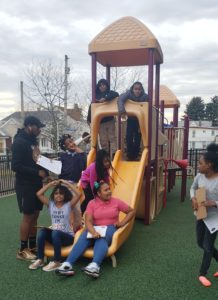
Our immediate solutions began with compiling resources for both families and educators. We recognized that for many of our youth and their families, the closure of schools would be not just a loss of education, but also food, healthcare, support, and socialization. To assist in combatting this, we composed a list of food pick-up locations, at-home educational activities, and health and wellness resources. We adapted some of our own worksheets and curriculum to be virtually accessible. As educators ourselves, the switch from in-person to virtual learning seemed daunting. Our resource list for educators included platforms for virtual learning, pre-existing virtual activities, professional development opportunities, and articles. Both of these resource guides can be accessed here: https://drive.google.com/drive/u/0/folders/1ZaL_jXDG7Sb_PWCfWZ2aX7UqjIrM6RNf
The barriers of virtual learning at first seemed intimidating. We pride ourselves in providing engaging curriculum, and we struggled to brainstorm ways to actively connect with our youth behind computer screens. Much of our curriculum focused on hands-on, problem-based learning – we loved being able to build, discuss, and grow with our students. Many of our activities involved group work and the sharing of materials, and these components seemed impossible in a virtual space. Not only were our students not able to share materials, but many of our students did not have access to the materials needed for our lessons. The realization of this barrier led us to the development of our curriculum kits. We created four different curriculum kits with each kit providing instructions and necessary materials for at-home learning. Over the past couple months, these kits have been utilized by both individual families and participants in community organizations. Some students have completed the activities on their own, while other groups of students have learned with us in real time over video calls. Teaching in real time allows us to have meaningful discussions with our youth even while socially distant.

We have learned through this process while that virtual learning can have its setbacks, it also has its perks. Commuting to different neighborhoods in Allegheny County was once an important factoring in determining where to deliver our curriculum. Now more than ever, we’ve been able to connect with students from communities outside of our typical traveling. Rather than anxiously packing enough materials for an in-person lesson, we feel relief in knowing that each of our virtual students has the exact amount of materials needed.
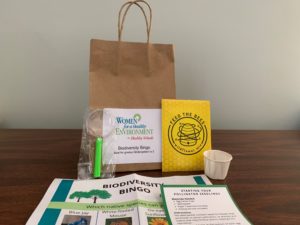
The transition to virtual teaching has allowed us to re-think the way we formulate lesson plans and become creative in the delivery of curriculum. We started to film videos to pair with our curriculum kits to better serve as an at-home educational resource. We incorporated icebreakers that encourage physical movement into virtual spaces. We have utilized a variety of learning platforms, such as Kahoot and Padlet, to enhance the virtual learning experience. While we are anxious to return to routine in-person teaching when it’s safe to do so, we feel confident in our ability to provide virtual activities and lessons to the communities we serve.
This post was authored by our KEYS Americorps member, Evelyn Garon, as part of her 2019-2020 Service Year.
The Importance of Healthy Schools
We live in a time where, more than ever, the importance of healthy schools is paramount.
As disruptive as the federal stay-at-home orders are for many families, it can be especially harmful for families and caregivers who rely on schools to provide essential services for their children. As the lines outside of Pittsburgh Public Schools’ Grab and Go sites indicate, thousands of families rely on schools to provide meals for their children. According to one statistic, almost 30 million children in America receive 1 or more of their meals at school. This number swells in size when we account for after-school provider meals, summer meals, and school breakfasts. This is especially important as we consider that almost 1 in every 5 children in America experiences childhood hunger and family food insecurity; and that children represent 45% of Supplemental Nutritional Assistance Program recipients. For many American families, school meals are some of the only reliable food they can access for their children.
A growing number of children access most of their health services from schools across over 1,500 school-based health care sites. Preliminary research suggests that schools function as the ‘de facto mental health system for children and adolescents’, with 70-80% of all child and adolescent mental health services delivered in a school setting – making schools one of the only places where children can receive mental health and behavioral supports.
It is clear that schools are essential institutions for entire communities. Schools are also front-line sites that deliver essential public health services, including monitoring health status of individuals in our community; informing, educating, and empowering families about their health; mobilizing community partnerships to solve community health problems; linking individuals and families to health services and health insurance; and educating a competent health workforce for the future.
Children spend over 1,000 hours a year in their school buildings. This is the setting, outside of the home, where children spend the most time learning, growing, and playing. While they are in school they are learning not just their assigned subject areas, but they are learning how to live in a world with other people, how to resolve conflict, how to grow, and change and adapt. While they are in school, our children are growing into the artists, scientists, leaders, problem-solvers, change-makers, and innovators of the future.
Advocating for healthy schools is not just about ‘green school’ aesthetics. It’s not just about sustainability, or equitable consumption of resources, or carbon footprints. Healthy schools are about – at the end of the day, our work is always about – our children, their health, and their success. Working towards healthy schools also means advocating for and assuring the good health and wellness of the people who care for our children. We believe strongly in the research that suggests that student health is foundational to student success.
We want children to return to schools that are prepared to meet their needs. In this moment, we are learning a lot about what changes we will need to make to support our students, our teachers, and our school staff in the future. When schools re-open, we want them to be equipped to be successful in meeting the needs of every child. Every child deserves a healthy school where they can learn, grow, and play. Every child deserves the right to learn in a safe and toxic-free setting. Every parent, educator, and school staff person deserves the comfort of knowing that school buildings are free of mold, environmental hazards like lead, radon, and asbestos, and pests.
In order to make this a reality, we need equitable distribution of resources.
We need committed fiscal investment into our aging public school infrastructure.
We need to prioritize support for school staff, including school nurses, school psychologists, behavioral therapists, food services workers, and facilities, custodial, and maintenance staff.
We need to come together, as advocates, parents, neighbors, educators, and decision-makers, to support our shared vision of healthy schools for every child.
References:
https://www.nokidhungry.org/who-we-are/hunger-facts
https://schoolnutrition.org/aboutschoolmeals/schoolmealtrendsstats/
Pesticide Action Month
Integrated Pest Management 101
IPM, or integrated pest management, is a safe, effective, and scientific approach to managing pests. IPM uses knowledge of pests’ habits and needs to help implement pest prevention tactics first, and uses pesticides only when necessary selecting effective pesticide products that pose the least risk of exposure to people and the environment.
Pests in schools can destroy property, contaminate food, bite or sting people, and worsen other health issues. For example, certain pest infestations can trigger or worsen asthma incidence, and pests can spread infectious and deadly diseases. However, routine pesticide use, particularly sprays, may lead to unacceptable chemical exposure risks. Children spend approximately 1,100 hours per year in school buildings. Kids are especially sensitive to some pesticides because of their small size and developing bodies. Parents, health care workers, and school officials are increasingly looking to reduce potential student and staff exposures to toxins in the school setting.
IPM use in schools considers the causes of pest infestations and focuses on preventative tactics. IPM provides more effective and longer-term control. IPM uses routine inspections with intervention only when necessary. Therefore, pesticide treatments, if needed, are reduced and limited to pest hot spots, or are eliminated altogether.
Because IPM also seeks to reduce children’s pesticide exposure, less risky products and formulations are selected. Additional benefits of IPM include more effective pest management, reduced clutter, improved cleanliness, and better energy efficiency in buildings due to proper maintenance.
Did you know?
PA state law requires school and childcare centers to use IPM techniques and tools to reduce chemical exposure for students and staff. 48 hour notice must be given to school community members and surrounding neighbors, as well as residents on the Hypersensitivity Registry, prior to chemical pesticide application. Click here or more information on the Hypersensitivity Registry or the PA IPM for Schools Program.
Why we support IPM in Schools and Childcare Centers
- IPM Protects Health
By reducing the use of chemical pesticide exposures, we are protecting the health of our children and school and childcare center professionals. An NHANES study found that children aged 6-11 carry the most amount of pesticide exposure nationally – more than any other age group. Our children’s health is foundational to their success in school – allowing them to develop cognitive and social skills and achieve academic success. - IPM Protects the Environment
IPM promotes the use of alternative products and safer chemical formulations when pesticides are necessary. Botanical active products, for example, use essential oils derived from plants who use these oils to protect themselves from bugs. These botanical-based products are safer for our waterways and animal and marine life. - IPM Prevents Pesticide-resistant Bugs and Weeds
Overuse of chemical pesticides such as pyrethoids can create pests and weeds that are resistant to chemicals. This means that if these pests return to the same location, you will need different, stronger, or a mix of more chemicals to deter them. Using evidence-based techniques to monitor and repel pests is always best.
Taking Action
We’ll be celebrating all month long as we launch our Pesticide Action Toolkit and host our second Integrated Pest Management training for school and childcare center staff. To learn more about our Toolkit, click here. To register for our upcoming training, click here.
Greener, Cleaner Arts and Crafts
Colder winter months often mean less time outdoors and more time feeling cooped up in our homes – making it an excellent time for an art project! Arts and crafts are a great way to get inspired and create something new. This month, we wanted to share fun and earth-friendly crafts that can be enjoyed by children, families, and classrooms! Sometimes crafting can require using a lot of new materials, and messy crafts often create a lot of waste. These crafts are the perfect solution – they can be made from materials you already own, they encourage us to appreciate the beauty of nature, and some of them are even helpful in supporting our local wildlife!
Upcycled Crafts
What is upcycling? It’s taking something you already own and no longer use and turning it into something new. In doing this, the result is often more valuable and beautiful than it previously was!
Wondering if there’s something you can do with old tin cans? With this craft, you can create adorable planters and bring outdoor life into your home!
This craft turns an old milk carton into the new favorite hangout spot for birds in your yard, as well as providing these feathered friends with food in scarce winter months.
Nature Crafts
These crafts utilize natural resources as crafting materials, allowing you bring some of the beauty of nature into your home!
These bookmarks are a unique way to preserve leaves and flowers from your yard. This craft becomes not only a bookmark, but also a keepsake—and all you need are some leaves and laminating sheets!
Collect leaves from your community and make these creative lanterns! This craft can bring illumination, ambiance, and beauty to your home in cold evenings.
Wildlife Friendly Crafts
Furry or feathered friends in your yard will thank you for these crafts!
In these colder winter months, we can share our bounty with those around us – including the feathered friends in our yards and communities! The birds you see in these colder months are those that have decided to stay in the area as opposed to migrating south, and a little generosity can go a long way!
Ever had a bird fly into your window at home? You can prevent these kinds of bird injuries by creating a bird deflector for your windows and helping birds differentiate between glass and open space!
Additional Resources:
- For all of your crafting needs, we recommend shopping at the Pittsburgh Center for Creative Reuse, located at the intersection of Wilkinsburg, Homewood, and Point Breeze! You can find an endless variety of materials here—all of which have been previously used, recycled, or donated—for incredibly cheap!
- Have you ever asked yourself: “How do I reuse _________?” This website has infinite ideas for you! https://craftingagreenworld.com/reuse-resources/
This post was authored by Evelyn Garon, our KEYS Americorps member (SY 2019-2020).
An Eco-Student’s Guide to Healthy Schools
As we enter our fifth year of programming at Healthy Schools PA, we are BEYOND excited to introduce our “Eco-Student’s Guide to Healthy Schools” workbook. The workbook, designed to be a student companion to our Healthy Schools Recognition Program, is an interactive guided inquiry into the systems that keep our school buildings running.
Using an investigative journalism lens, and with the goal of promoting science communication skills and environmental health literacy, the workbook was designed to be used with upper elementary and middle school students.
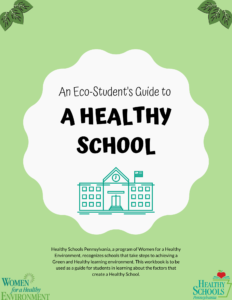
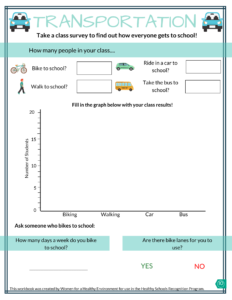
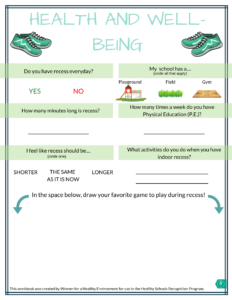
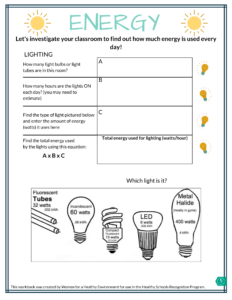
The workbook is a tool to help students investigate and learn about the different ways our school interacts with the environment. Our school buildings and the ways we use it can impact both our planet and our health in different ways.
In other words: when we protect our environment, we are also protecting our health.
Across the country, schools are working towards a sustainable future. Sustainability in schools means using practices that meet our current needs without making it more difficult for people in the future to meet their own needs. Schools can make huge impacts on our environment due to their size, because it takes a lot of resources to keep our school buildings running, such as energy that comes from renewable and non-renewable sources, water that comes from our local rivers, and food to feed every student.
This workbook will not only help you determine the ways your school is impacting the environment, but also spark your own ideas for eco-friendly changes you can make in your home, classroom, school, and community. Even small actions, such as switching out light bulbs for more efficient ones, can make a HUGE difference! Every sustainable act is a step in the right direction for a sustainable future.

We hope you take a chance to explore our workbook and have an opportunity to use it in your own classroom!
Celebrating Successes at the 4th Healthy Schools Summit!
Our 4th Annual Healthy Schools Summit was our biggest gathering yet! With over 60 educators, school administrators, parents, school board members, school facilities and custodial staff and community partners – we were so happy to host members representing each part of our growing network of healthy school advocates.
Erika Eitland, a PhD candidate and Program Manager of the Harvard University School of Public Health’s national laboratory for Schools for Health, was our keynote speaker. She shared the research linking the importance of healthy school buildings to student health, student cognition, and student academic performance. She also shared how making investments in school buildings can bring large, impactful returns on student wellness as a whole.
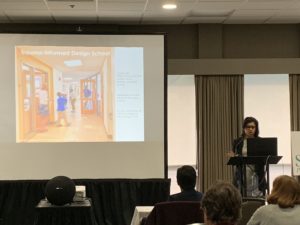
We also invited local leaders in school sustainability to join us for a Panel Discussion on what it takes to build healthy schools. Christine Schott, parent and Sustainability Coordinator for the Steel Valley School District shared her stories of success advocating for outdoor and garden education for all students in the district, as well some big wins for a district-wide recycling program! Jake Douglas, Food Services Director at Deer Lakes School District, discussed how the district makes it a priority to reduce waste in the lunchroom and support local farmers in their purchasing. Cassandra Brown, a school nurse at PPS Arsenal K-8 got a round of laughs and applause when she discussed her “Be a Thinker, Not a Stinker” program to improve personal hygiene education and access to a growing international student body population – bringing together innovative partnerships into the school to meet student needs in an empowering way. Vicki Ammar, a high school teacher at PPS Perry High School rounded out our panel, sharing an educator’s perspective for bringing partnerships and starting new initiatives within a school.

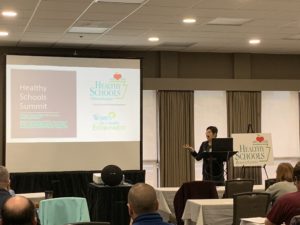
We had a networking and fun-filled working lunch, with Tracey Reed Armant, Program Officer at The Grable Foundation, presenting on “How to Write a Successful School Grant” from a Funder’s perspective.
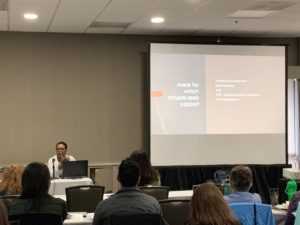
In the afternoon, we split into workshops to dive more in-depth. Katie Modic, of Communitopia, led our Educator Workshop, “Teaching Resiliency in the Classroom” which focused on hands-on climate education and bringing environmental justice into the classroom. Donnan Stoicovy, of State College Friends School, shared her school’s Zero-Waste journey and engaged participants in an interactive decision-making game for different school sustainability initiatives. LaKeisha Wolf, Director of Ujamaa/ Collective, and Monte Robinson, Community Schools Coordinator for the Pittsburgh Public Schools co-led our Parent and Partner Workshop on Engaging Parents and Partners for Healthy Schools. We all come to this work from different ways, and building on our shared goals has been central to pushing initiatives forward.
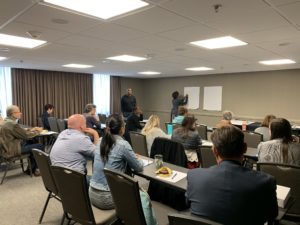
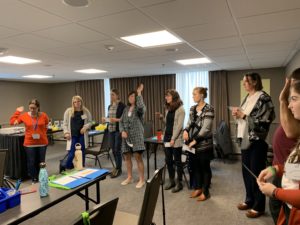
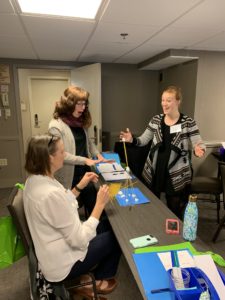


We left the Summit feeling excited for new connections, inspired by local rolemodels, and re-energized to continue the work towards building a healthy school for every child in our region!
To see presentations and workshop handouts from the Summit, please email Kara Rubio at Kara@WomenforaHealthyEnvironment.Org
